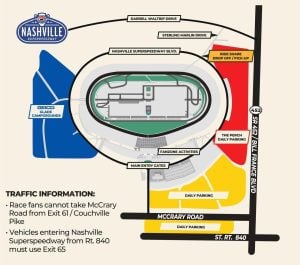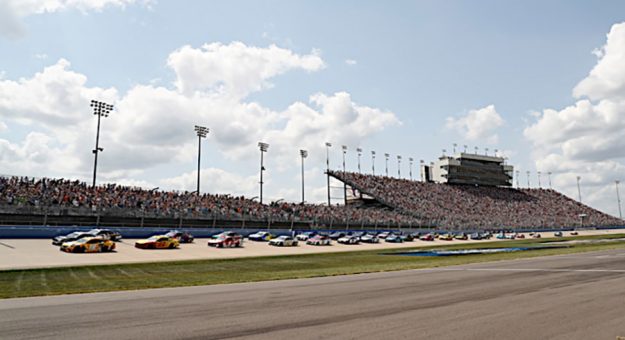A week before the NASCAR Cup Series’ second visit to Nashville Superspeedway, Erik Moses was “appropriately stressed.”
Moses, the president of the 1.33-mile track in Lebanon, Tenn., was in the final stages of prepping for this weekend’s Ally 400 (5 p.m. ET Sunday on NBC) and the Xfinity and Camping World Truck Series support races.
That included putting in place a few adjustments stemming from the track’s 2021 race weekend, which was NASCAR’s first visit to the track in a decade.
“Given where we, are what we have to do and the high hopes and expectations we have for how we will perform here for our fans, (I’m) appropriately stressed,” Moses told SPEED SPORT. “Things are going well and getting into place.”
What was the top thing stressing Moses a week out from his track’s moment in the spot light?
Tickets.
“I’m a promoter, right?” Moses said. “Last year, we were sold out three months in advance. If there is a ticket left to sell, I want it sold. We’re trying to make certain that we let (fans) know that there are tickets available for the Ally 400. Many people I think didn’t even try. Because last year, we sold out so quickly, they just assumed that they would be gone as quickly this year. And so there are tickets still available, we want to get all those sold. And just want to make certain that we’re getting the word out so that people understand what the changes and enhancements are that we’ve made here.”
Those attending the inaugural Ally 400, may have had some trouble getting into the track thanks to traffic and having to pay for parking.
Nashville Superspeedway officials have addressed both issues, by doing away with on-site parking fees and adding 2,600 parking spots on 20 acres of newly cleared land across the street from the track.
“The iron is out,” Moses said. “We’re ironing the wrinkles and steaming some as well.”
With temperatures expected to reach the 100s this weekend, the improvements include a vast array of way for fans to keep cool.
 Moses, a former president of an XFL team and lon-time executive in the sports and entertainment community, is in the midst of his second season operating Nashville Superspeedway after its resurrection.
Moses, a former president of an XFL team and lon-time executive in the sports and entertainment community, is in the midst of his second season operating Nashville Superspeedway after its resurrection.
Moses said what surprised him about his first year in the role was that the track “turned into a little city.”
“We had, I think over 1,000 RVs last year. People started arriving on Wednesday,” Moses recalled. “They stayed here until Monday. That doesn’t happen in any other sport that I’m aware of. So I think the dedication and commitment are a large part of our fan base. It was surprising, pleasantly surprising, but surprising. I really enjoyed going out on my golf cart to check things out and seeing the same people going for their morning walk on Friday and Saturday and Sunday around the track.”
There was one major change for the track in the 12 months since its last race weekend.
In December Dover Motorsports, which owned Nashville SS in addition to Dover Motor Speedway, completed a sale of the tracks to Speedway Motorsports, which is run by Marcus Smith.
Any significant upgrades to Nashville by Speedway Motorsports will materialize in the “coming year.”
“The word was, ‘let’s not change too much, too soon,'” Moses said. “‘Whatever you guys did last year worked well. But for the most part, let’s keep that up.’ … We have more time to institute that kind of change. But we benefit from being a part of a company that can trace its its roots in this sport back to the very beginning. … Our tracks in Charlotte, Atlanta and Texas have condos at the track, right? So Bruton Smith and Marcus are visionaries. And I think we will benefit from from that vision.
“I think being part of the Speedway Motorsports family will act as an accelerant to get Nashville Superspeedway where I want and we want it to go. Deeper pockets, more resources, greater bandwidth. And I’ve got nine other track presidents around the country that I can call up and say, ‘Hey, what do you think about this? What was your experience with that?’ And that’s very helpful.”
With last year’s race selling out, the track had to bring in temporary grandstands that stretch all along the frontstretch.
Time will tell if more permanent sitting will be installed at the 20-year-old facility.
“Not until we know where the demand is,” Moses said. “Last year was an inaugural year. So you almost kind of discard that as an anomaly. So we’ll be checking over the next couple of years to see where the demand actually lands. And then we’ll make investments commensurate with where we think the demand is. … This is the kind of company that would make the kind of investment to ensure that we have permanent grandstands that are the appropriate size and capacity for the crowds that we can come to expect.”
